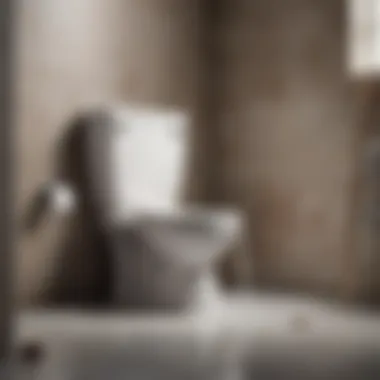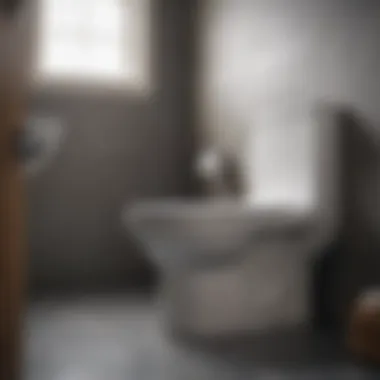Mastering Toilet Plunging: A Comprehensive Guide


Intro
Toilet plunging is a task that many find unpleasant, yet it is a necessary skill for maintaining the functionality of one’s bathroom. Understanding how to effectively plunge a toilet can empower individuals to handle common plumbing issues with confidence. This guide aims to break down the process, detailing the appropriate tools and steps to take.
In any household, blockages can occur unexpectedly. This can lead to minor inconveniences or major disruptions. Thus, having the knowledge to address these issues is essential. In this article, readers will gain insights into the mechanics of plunging and common pitfalls to avoid.
Tools Required
Before diving into the technique itself, gathering the right tools is crucial. A quality toilet plunger is the most important item. There are two main types of plungers:
- Cup Plunger: Ideal for flat surfaces, best for sinks.
- Flange Plunger: Designed specifically for toilets, featuring an extended flange at the bottom to create a better seal.
Other tools that may assist include:
- Rubber gloves to maintain hygiene.
- A bucket to manage excess water, if necessary.
- Towels for any spills that may occur during the process.
Steps to Properly Plunge a Toilet
Once equipped with the necessary tools, follow these steps:
- Preparation: Ensure the area is dry; remove any items from around the toilet to avoid damage.
- Check Water Level: If the toilet bowl is full, it may need to be emptied. A good level is enough water to cover the plunger.
- Position the Plunger: Place the plunger in the toilet bowl, ensuring the flange fits snugly inside the drain hole.
- Push Down: Press the plunger down gently to remove air, creating a better seal.
- Plunge Firmly: Pull the plunger back sharply, then push down quickly. Repeat this motion consistently to build pressure against the blockage.
- Check if Unblocked: After several plunges, lift the plunger to see if the water drains. If it does, flush the toilet to confirm it's clear.
"Effective plunging relies on creating a strong seal with the plunger. This action compresses air, helping to dislodge the blockage."
Common Mistakes to Avoid
When attempting to plunge, people often make mistakes that can hinder the process. Here are some key errors to watch out for:
- Using the Wrong Plunger: Opting for a standard cup plunger can lead to ineffective results. Always use a flange plunger for toilets.
- Not Creating a Seal: Failing to ensure a complete seal can prevent effective plunging.
- Yanking Too Hard: Excessive force can cause overflow. Controlled movements are more effective.
Finale
Mastering the toilet plunging technique is about understanding the tools, following effective steps, and avoiding common mistakes. Equip yourself with the right plunger, learn to apply the technique properly, and you will handle toilet blockages efficiently. This knowledge not only saves time but also keeps the bathroom operating smoothly.
Understanding the Basics of Toilet Clogs
Toilet clogs are common household problems that everyone faces at some point. Understanding the basics of how and why clogs occur can make a substantial difference in handling toilet issues efficiently. This knowledge is vital not only for immediate resolution but also for preventing future incidents.
When a toilet is clogged, it is more than just an inconvenience; it can lead to more significant plumbing problems if ignored. A well-functioning toilet is a cornerstone of a healthy bathroom environment, so recognizing the mechanics behind clogs is essential.
Common Causes of Toilet Clogs
Several factors lead to toilet clogs. Knowing these can help you address the issue before it escalates. Some common causes include:
- Excessive toilet paper: Flushing large amounts of toilet paper consistently can create blockages.
- Foreign objects: Items such as toys, hygiene products, or paper towels should not be flushed.
- Tree roots: In older homes, roots can invade sewer lines and cause backups.
- Low water levels: Toilets with insufficient water pressure may not flush properly, leading to clogs.
These causes highlight the importance of vigilance in bathroom practices.
The Importance of Addressing Clogs Promptly
Addressing clogs as soon as they occur is crucial for several reasons. The longer a clog sits unattended, the more likely it will worsen. This can lead to:
- More extensive damage: Over time, a small clog may cause pipes to back up, leading to leaks or flooding.
- Increased repair costs: Ignoring a clog could result in professional intervention that is often more expensive than DIY approaches.
- Health risks: Standing water can attract pests and promote mold, creating a hazardous living environment.
Essential Tools for Plunging
To effectively address toilet clogs, having the right tools is essential. The correct equipment can make the difference between a simple fix and a prolonged battle with a stubborn blockage. Ensuring that you are adequately prepared can reduce frustration and yield quicker results. There are key items that should be included in your arsenal when tackling this common household issue.


Choosing the Right Plunger
The plunger is the primary tool for resolving toilet clogs. However, not all plungers are alike. There are two main types: the standard cup plunger and the flange plunger.
- Standard Cup Plunger: This type has a rubber suction cup that works well for sinks or bathtubs but may struggle with toilets. It lacks the added features that make plunging toilets more effective.
- Flange Plunger: This plunger is specially designed for toilets. It features an extended rubber flap, or flange, that fits snugly into the toilet drain. This design allows for a better seal, optimizing pressure when plunging. Always opt for a flange plunger for tackling toilet issues.
When selecting a plunger, ensure it is made of durable materials. A sturdy handle and a robust rubber cup will provide better longevity and performance. Regular inspection of your plunger is necessary. Look for any cracks or damage that may compromise its efficiency.
Additional Tools That May Be Useful
While a plunger is often sufficient for most clogs, other tools can come in handy. Consider the following:
- Toilet Auger: This tool is useful for deep clogs that a plunger cannot resolve. It consists of a long, flexible cable with a handle that can reach deep into the toilet's drain, breaking apart obstructions.
- Rubber Gloves: It is wise to protect your hands from germs and cleaning chemicals. Choose gloves that are long enough to cover your forearms for added protection.
- Bucket: Keeping a bucket nearby can be helpful for emergency overflow. If water begins to rise dangerously high in the toilet, you can scoop it out to avoid mess.
- Masking Tape: In some situations, it may be helpful to place tape around the toilet base to prevent leaks during plunging. This is particularly useful if you are dealing with a significant blockage.
Having the right tools not only enhances your efficiency but also ensures safety during the plunging process.
Preparing to Plunge
Before attempting to plunge a toilet, it is pivotal to be properly prepared. This phase can significantly influence the effectiveness of your efforts and reduce the chance of making the situation worse. Taking time to plan this step can save effort later and promote a cleaner, safer experience overall.
Assessing the Situation
An important aspect of preparing to plunge is to assess the situation thoroughly. Understanding the severity of the clog will guide your actions. Is water still standing in the bowl? Or is it draining slowly? Different scenarios may require different approaches. Carefully observing the water level can help. If the toilet is overflowing, it is wiser to act promptly to prevent mess. For minor slowdowns, plunging might work without extra steps.
When evaluating the clog's nature, consider what might have caused it. Common culprits include excessive toilet paper or foreign objects. Identifying the cause can help manage expectations about the plunging process.
Gathering Necessary Materials
After assessing the situation, the next step is gathering necessary materials. You need the right tools to be efficient. First and foremost, a plunger is essential. Ensure it is a flange plunger, which is built for toilets. Next, have rubber gloves on hand to maintain hygiene. It is also wise to keep old towels or newspapers nearby. Plunging can be messy, and having them can safeguard your floors and catch any spilled water.
Additionally, you may want to have a bucket handy. In cases where water drains poorly, using a bucket can help remove excess water. This makes plunging more manageable and less messy.
Protecting Your Hands and the Area
Ensuring safety and cleanliness before you start is crucial. Protecting your hands and the area will lead to a smoother process. Wearing rubber gloves will create a barrier against bacteria and unpleasant odors. Even if the toilet looks clean, it is wise to take precautions.
Furthermore, consider laying down old towels around the base of the toilet. This will help absorb any overspill while you plunge and protect your flooring. Make sure to keep your feet dry to prevent slipping. A dry workspace is a safer workspace. Taking these protective steps before plunging will enhance your confidence and efficiency in solving the problem.
The Proper Technique for Plunging
Understanding the proper technique for plunging is essential for effective toilet maintenance. A good plunging method not only clears blockages but also prevents damage to your toilet. While it may seem straightforward, several specific elements combine to ensure successful results. Failing to apply these techniques correctly can lead to frustration and additional plumbing issues.
Stance and Grip
The way you position your body is critical when plunging. Stand with your feet shoulder-width apart for stability. Bend your knees slightly to maintain balance while you work. Your grip on the plunger is also vital. Hold the handle firmly with both hands. This allows you to apply sufficient pressure. It is best to keep your elbows slightly bent as this gives you more control over the movement.
Creating a Seal Around the Drain
Before you start plunging, ensure you create a tight seal around the drain. To do this, place the plunger cup over the drain opening. Make sure it covers the entire opening without leaving any gaps. A proper seal is crucial because it allows the force from the plunge to be channeled effectively into the clog, maximizing your chances of success.
Tip: If your toilet has a low water level, you may want to add a little water to the bowl first. This will help to create a better seal when the plunger is pressed down.
Executing the Plunge
When you begin to plunge, remember to use a strong and consistent motion. Start with a firm downward force and then lift the plunger up, breaking the seal momentarily, before pushing down again. This up and down motion should be executed steadily, alternating between both actions. The power of the downward thrust is what helps to dislodge the clog from the drain. Maintaining a rhythm can often make the task easier and more effective.
Knowing When to Stop
Recognizing when to stop plunging can save you from unnecessary effort and potential damage. If after several attempts, the water level in the bowl does not start to drop, or the toilet continues to back up, it's time to reassess. Continuous plunging without effect could indicate a more serious clog, perhaps further down the plumbing system. At this point, consider seeking professional help or using additional tools to address the issue.


Aftercare Following Plunging
After effectively plunging a clogged toilet, the process doesn't simply end. It is essential to engage in aftercare, which ensures that your toilet functions reliably in the future. Proper aftercare includes several important steps, each contributing to maintaining your toilet and preventing future issues.
Checking for Remaining Clogs
Once you finish plunging, the first task is to assess whether the clog has been successfully removed. Start by flushing the toilet. Observe how the water flows; if it drains smoothly, the blockage may have been resolved. However, if the water rises again or drains slowly, it indicates that some obstruction remains. It is wise to repeat the plunging process if necessary. In some cases, you might need to try a toilet auger for deeper clogs. Make sure the toilet is flushed a few times to confirm its full functionality.
Cleaning Up the Area
Plunging a toilet can be a messy affair. Thus, addressing any spills or splashes is crucial. Begin by wiping down the handle and all areas around the toilet that may have come into contact with germs or dirty water. Use disinfectant wipes or a cleaning spray, effective against common bacteria and viruses. Disposal of cleaning materials should be careful too. Place used paper towels or rags in a garbage bag, sealing it before discarding. Maintaining hygiene post-plunge cannot emphasize enough; it keeps your bathroom environment safe and tidy.
Proper Tool Maintenance
Maintaining your plunging tools is an often-overlooked aspect of aftercare. After you clean the area, pay attention to your plunger. Rinse it thoroughly with hot water and a mild detergent. It is vital to eliminate any remnants of grime or waste to prevent future odors and bacteria from developing. Store it in an upright position to keep the rubber in shape. If you have used an auger, clean it in a similar manner. Always check tools regularly, replacing them if they show signs of wear or damage. This ensures they are effective when you need them most.
Proper aftercare is as crucial as plunging itself. Neglecting these steps may lead to reoccurring toilet problemes and hygiene issues.
When to Seek Professional Help
Toilet plunging can often resolve minor clogs, but there are situations where professional intervention becomes necessary. Recognizing the signs that indicate a more serious issue is key for homeowners. Ignoring these signs may lead to greater plumbing problems, increased costs, and potential health hazards. By understanding the circumstances that warrant calling a professional, you can ensure that your toilet remains functional and safe for your household.
Signs of a More Serious Problem
Several indicators suggest that a clog is part of a larger issue. Some common signs include:
- Frequent Clogs: If your toilet frequently becomes clogged despite using proper plunging techniques, this may signal a deeper obstruction in the plumbing system.
- Gurgling Sounds: Unusual noises emanating from the toilet or drains can indicate air trapped in the plumbing, suggesting that there might be a blockage further down the line.
- Backflow: If water or sewage begins to backflow into other drains, the problem is likely beyond just the toilet. This scenario requires immediate attention to prevent contamination.
- Multiple Fixture Issues: When more than one fixture, like the sink and bathtub, are showing signs of slow drainage, an overarching plumbing problem may exist.
If you experience any of these signs, it is wise to consult a plumbing professional. They possess the necessary expertise to diagnose and address complex issues effectively.
Understanding Your Limitations
Knowing your limits when it comes to DIY plumbing is crucial. While many people can successfully unclog a toilet, certain situations are better left to professionals. Here are points to consider:
- Complexity of the Problem: If conventional plunging fails, more complex issues like tree roots invading pipes or a severely misaligned sewer line may be present. Attempting to resolve such issues without expertise can exacerbate the problem.
- Lack of Equipment: Specialized plumbing equipment, such as drain snakes or cameras, may be necessary to identify or remove stubborn blockages. Most homeowners do not own such tools.
- Time and Safety: Trying to fix a serious plumbing issue can consume significant time. Moreover, there are safety risks with chemicals or heavy equipment, which require the right training to handle safely.
Determining when to call a professional can save time, money, and effort. If you feel overwhelmed or unsure, it is wiser to seek expert help rather than risk a costly mishap.
Tips for Preventing Future Clogs
Toilet clogs can be a frustrating and inconvenient issue. Preventing these clogs before they happen is key to maintaining your toilet's functionality and avoiding unnecessary hassles. In this section, we will explore various strategies to keep your toilet in optimal condition and reduce the likelihood of blockages.
Having a proactive approach not only saves time but also saves money in the long term. By employing proper disposal practices and regular maintenance, homeowners can create a more enjoyable bathroom experience.
Proper Disposal Practices
Improper disposal of items in the toilet is one of the leading causes of clogs. Understanding what should and shouldn't go down the toilet is essential. Many people mistakenly treat the toilet as a trash can. This behavior can lead to buildup and potential disasters. Some of the common items to avoid include:
- Paper Towels: Unlike toilet paper, paper towels do not break down easily and can quickly lead to a blockage.
- Feminine Hygiene Products: Items like pads or tampons expand and do not decompose in water.
- Cotton Balls and Swabs: Such products rarely dissolve and can gather with other waste, creating effective blockages.
- Dental Floss: Surprisingly, floss can combine with other materials and lead to significant clogs.
By educating family members or housemates about what belongs in the trash bin instead of the toilet, you can minimize the risk of clogs. Placing a visible trash can near the toilet adds a convenient alternative for disposal.
Regular Maintenance Approaches
A consistent routine is crucial for preventing future clogs. Regular maintenance not only enhances the performance of the toilet but also prolongs its lifespan. Some crucial activities to consider include:
- Routine Inspections: Periodically check for any signs of leaks or wear in toilet parts. Addressing small issues early can prevent bigger problems later.
- Flushing Practices: Encourage family members to use the toilet efficiently. Flushing once for solid waste and ensuring everything is cleared can reduce clogs.
- Cleaning the Toilet: Use safe, non-abrasive cleaners to maintain the toilet bowl and its components. Keeping the toilet clean ensures that waste flows smoothly.
- Water Level Check: If the water level in the toilet bowl is too low or too high, it can affect flushing. Make adjustments as necessary to ensure that the toilet flushes effectively.
Regular maintenance practices, although they take a little time, can save you effort and money in the long run.


"Prevention is better than cure." Practicing good habits ensures your toilet stays functional and hassle-free.
Understanding Different Toilet Types
Understanding the different types of toilets is essential when it comes to proper toilet maintenance, including plunging techniques. Each toilet type operates on distinct principles and mechanics, which can significantly impact clogging issues. Hence, recognizing how your specific toilet functions can help tailor your approach to plunging, ensuring more effective results.
Knowing the attributes of different toilet types also allows for better preparation. For example, some toilets might have unique flushing systems that require a specific method for unclogging. Additionally, awareness of these differences can help in choosing the right tools, as plunging methods vary depending on the toilet design.
Gravity-Flush Toilets
Gravity-flush toilets rely on the force of gravity to operate. When the flush valve is lifted, water from the tank flows down into the bowl, creating a siphon effect that removes waste. This is the most common type of toilet found in homes.
With these toilets, plunging tends to be more straightforward. The design allows for a good seal with a standard flange plunger. It's crucial to ensure the plunger's rubber cup is large enough to cover the drain hole completely for optimal performance.
Benefits of Gravity-Flush Toilets:
- Reliability: They are typically low maintenance, requiring fewer repairs.
- Simplicity: Most people are familiar with them, making troubleshooting easier.
One consideration to note is that excessive force during plunging can potentially damage the components within the tank. Thus, a firm yet cautious approach is essential.
Pressure-Assisted Toilets
Pressure-assisted toilets use air pressure to force water into the bowl during a flush. This design results in a more powerful flush, which can be advantageous for clearing tough clogs. However, this type can pose challenges when it comes to plunging.
Using a traditional plunger may not be effective. A toilet auger is often more suited for pressure-assisted toilets, as it can navigate the unique shapes of their drainage systems.
Key Features of Pressure-Assisted Toilets:
- Stronger Flush: They often clear waste more effectively.
- Noise Level: They tend to be noisier than gravity-flush models during a flush.
When attempting to plunge or clear a clog in this type of toilet, it is vital to remain cautious, as using too much force can lead to damage of the pressure canister.
Dual-Flush Toilets
Dual-flush toilets feature two buttons or a lever, allowing users to select between a full flush and a half flush, conserving water. This type is gaining popularity due to its sustainability benefits. From a maintenance standpoint, they can behave like both gravity-flush and pressure-assisted toilets, depending on their internal mechanisms.
For plunging, it is essential to gauge what type you are working with. If the flush mechanism is more akin to a gravity system, a standard flange plunger will suffice. For those resembling pressure-assisted toilets, an auger may be required.
Considerations for Dual-Flush Toilets:
- Water Conservation: Saves significant amounts of water compared to traditional toilets.
- Maintenance Needs: Careful identification of the mechanism involved can save time.
In summary, understanding toilet types helps tailor plunging techniques effectively. Proper grasp of their functions can lead to more successful unclogging while minimizing potential damage.
Culmination: Mastering Toilet Maintenance
Mastering toilet maintenance is essential for every homeowner. A well-functioning toilet is often taken for granted until a clog occurs, leading to inconvenience and potential damage. This article has aimed to equip you with the knowledge needed to effectively manage toilet issues, particularly through plunging techniques. By understanding the mechanics behind different toilet types, the proper tools, and the steps involved in plunging, you can address common problems efficiently.
A significant benefit of mastering this skill lies in its practicality. Knowledge of effective plunging techniques not only prevents minor annoyances but also mitigates the need for costly professional services. Handling minor clogs yourself fosters confidence and saves time.
Considerations around proper maintenance practices are equally important. Regular checks can prevent build-up, and adopting good habits can extend the life of your toilet.
"Preventive measures always yield better results than reactive solutions."
Recap of Key Techniques
In reviewing the key techniques discussed in this guide, focus on the following:
- Choosing the Right Plunger: Selecting a toilet plunger that fits your needs is crucial. A flange plunger is generally most effective for toilets.
- Assessing the Situation: Check the severity of the clog before plunging. Identify if it’s a minor blockage or a more complex plumbing issue.
- Executing the Plunge: Utilize a firm stance and grip the plunger correctly to create a seal. The plunging action should be vigorous but controlled.
- Aftercare: Always check for remaining clogs after plunging and clean the area properly. Frequent maintenance can prevent future issues.
Encouragement for Continued Learning
I encourage you to keep learning about toilet maintenance and home plumbing systems. Understanding the mechanics will not only help you with plunging but also with identifying issues before they escalate. Educate yourself about the different types of toilets and their functioning.
Also, consider exploring online communities or resources where shared experiences can offer valuable insights. Platforms like Reddit and Facebook cover home maintenance topics in detail.
In mastering these techniques and appreciating ongoing education, you can greatly improve your home maintenance skills. This empowers you to manage your living spaces with confidence and competence.







